Spatiotemporal Variations of Meteorological Droughts and the Assessments of Agricultural Drought Risk in a Typical Agricultural Province of China
Abstract
1. Introduction
2. Materials and Methodology
2.1. Study Area and Data
2.2. Calculation of SPEI and SYRS
2.3. Assessment of Agriculture Drought Risk
3. Results and Discussions
3.1. Drought Patterns at Different Timescales
3.2. Spatial Patterns in Drought Frequency and Drought Trends
3.3. Response of Crop Yield to Different Timescales of Drought
3.4. Assessment of Agricultural Drought Risk
3.5. Features and Limitations
4. Conclusions
- (1)
- The droughts have become more serious and frequent in Shaanxi Province after 1995, and the most severe drought episodes occurred in 2015–2016. On a spatial pattern, the most significant decreasing trend appears in the central plains of the province, where is the main producing area of the province’s grain.
- (2)
- Medium-term droughts (quantified by SPEI-06) that occurred in March contribute the most to yield losses for winter wheat; yield loess of summer maize is more sensitive to the short-term drought (quantified by SPEI-03) that occurred in August.
- (3)
- Despite the spatial distribution and extent of agricultural drought risk are affected by the timescale of SPEI, some areas in the north of the province are exposed to the higher agricultural drought risks than other regions.
Author Contributions
Funding
Conflicts of Interest
References
- FAO. The Impact of Disasters and Crises on Agriculture and Food Security. 2017. Available online: http://www.fao.org/emergencies/resources/documents/resources-detail (accessed on 9 September 2019).
- IPCC. Climate change 2014: Impacts, adaptation, and vulnerability. Part a: Gloal and sectoral aspects. In Contribution of Working Group II to the Fifth Assessment Report of the Intergovernmental Panel on Climate Change; Cambridge University Press: Cambridge, UK, 2014; pp. 1–32. [Google Scholar]
- Samaniego, L.; Thober, S.; Kumar, R.; Wanders, N.; Rakovec, O.; Pan, M.; Zink, M.; Sheffield, J.; Wood, E.F.; Marx, A. Anthropogenic warming exacerbates european soil moisture droughts. Nat. Clim. Chang. 2018, 8, 421–426. [Google Scholar] [CrossRef]
- Kiem, A.S.; Johnson, F.; Westra, S.; van Dijk, A.; Evans, J.P.; O’Donnell, A.; Rouillard, A.; Barr, C.; Tyler, J.; Thyer, M.; et al. Natural hazards in australia: Droughts. Clim. Chang. 2016, 139, 37–54. [Google Scholar] [CrossRef]
- Seager, R.; Hoerling, M.; Schubert, S.; Wang, H.; Lyon, B.; Kumar, A.; Nakamura, J.; Henderson, N. Causes of the 2011–14 california drought. J. Clim. 2015, 28, 6997–7024. [Google Scholar] [CrossRef]
- Lin, W.; Wen, C.; Wen, Z.; Gang, H. Drought in southwest china: A review. Atmos. Oce. Sci. Lett. 2015, 8, 339–344. [Google Scholar]
- Hall, J.W.; Leng, G. Can we calculate drought risk… and do we need to? Wires Water 2019, e1349. [Google Scholar] [CrossRef]
- Zhang, B.; AghaKouchak, A.; Yang, Y.; Wei, J.; Wang, G. A water-energy balance approach for multi-category drought assessment across globally diverse hydrological basins. Agric. For. Meteorol. 2019, 264, 247–265. [Google Scholar] [CrossRef]
- Palmer W, C. Meteorological drought. Res. Pap. 1965, 45, 58. [Google Scholar]
- McKee, T.B.; Doesken, N.J.; Kleist, J. The relationship of drought frequency and duration to time scales. In Proceedings of the 8th Conference on Applied Climatology; AMS: Boston, MA, USA, 1993; pp. 179–183. [Google Scholar]
- Vicente-Serrano, S.M.; Beguería, S.; López-Moreno, J.I. A multiscalar drought index sensitive to global warming: The standardized precipitation evapotranspiration index. J. Clim. 2010, 23, 1696–1718. [Google Scholar] [CrossRef]
- Svoboda, M.; Fuchs, B. Handbook of drought indicators and indices; National Drought Mitigation Center: Lincoln, NE, USA, 2016. [Google Scholar]
- Zargar, A.; Sadiq, R.; Naser, B.; Khan, F.I. A review of drought indices. Environ. Rev. 2011, 19, 333–349. [Google Scholar] [CrossRef]
- Pedro-Monzonís, M.; Solera, A.; Ferrer, J.; Estrela, T.; Paredes-Arquiola, J. A review of water scarcity and drought indexes in water resources planning and management. J. Hydrol. 2015, 527, 482–493. [Google Scholar] [CrossRef]
- Alley, W.M. The palmer drought severity index: Limitations and assumptions. J. Appl. Meteorol. Clim. 1984, 23, 1100–1109. [Google Scholar] [CrossRef]
- Wells, N.; Goddard, S.; Hayes, M.J. A self-calibrating palmer drought severity index. J. Clim. 2004, 17, 2335–2351. [Google Scholar] [CrossRef]
- Ma, M.; Ren, L.; Yuan, F.; Jiang, S.; Liu, Y.; Kong, H.; Gong, L. A new standardized palmer drought index for hydro-meteorological use. Hydrol. Process. 2014, 28, 5645–5661. [Google Scholar] [CrossRef]
- Mukherjee, S.; Mishra, A.; Trenberth, K.E. Climate change and drought: A perspective on drought indices. Curr. Clim. Change Rep. 2018, 4, 145–163. [Google Scholar] [CrossRef]
- Labudová, L.; Labuda, M.; Takáč, J. Comparison of spi and spei applicability for drought impact assessment on crop production in the danubian lowland and the east slovakian lowland. Theor. Appl. Climatol. 2016, 128, 491–506. [Google Scholar] [CrossRef]
- Vicente-Serrano, S.M.; Camarero, J.J.; Azorin-Molina, C. Diverse responses of forest growth to drought time-scales in the northern hemisphere. Glob. Ecol. Biogeogr. 2014, 23, 1019–1030. [Google Scholar] [CrossRef]
- Potopová, V.; Boroneanţ, C.; Boincean, B.; Soukup, J. Impact of agricultural drought on main crop yields in the republic of moldova. Int. J. Climatol. 2016, 36, 2063–2082. [Google Scholar] [CrossRef]
- Vicente-Serrano, S.M.; Beguería, S.; Lorenzo-Lacruz, J.; Camarero, J.J.; López-Moreno, J.I.; Azorin-Molina, C.; Revuelto, J.; Morán-Tejeda, E.; Sanchez-Lorenzo, A. Performance of drought indices for ecological, agricultural, and hydrological applications. Earth Interact. 2012, 16, 1–27. [Google Scholar] [CrossRef]
- Zeng, Z.; Wu, W.; Li, Z.; Zhou, Y.; Guo, Y.; Huang, H. Agricultural drought risk assessment in southwest china. Water 2019, 11, 1064. [Google Scholar] [CrossRef]
- He, B.; Wu, J.; Lü, A.; Cui, X.; Zhou, L.; Liu, M.; Zhao, L. Quantitative assessment and spatial characteristic analysis of agricultural drought risk in china. Nat. Hazards 2012, 66, 155–166. [Google Scholar] [CrossRef]
- Zhang, Q.; Sun, P.; Li, J.; Xiao, M.; Singh, V.P. Assessment of drought vulnerability of the tarim river basin, xinjiang, china. Theor. Appl. Climatol. 2014, 121, 337–347. [Google Scholar] [CrossRef]
- Shaanxi Provincal Bureau of Statistics. The Statistical Yearbook 2018 in Shaanxi Province. Available online: http://tjj.shaanxi.gov.cn/upload/201802/zk/indexch.htm (accessed on 9 September 2019).
- Hutchinson, M.F.; Xu, T. Anusplin Version 4.2 User Guide; Centre for Resource and Environmental Studies, The Australian National University: Canberra, Australia, 2014; p. 54. [Google Scholar]
- Allen, R.G.; Pereira, L.S.; Raes, D.; Smith, M. Crop evapotranspiration-guidelines for computing crop water requirements-fao irrigation and drainage paper 56. FAO, Rome 1998, 300, 6541. [Google Scholar]
- Shaanxi Provincal Bureau of Statistics. The Statistical Yearbook of Shaanxi Province. Available online: http://tjj.shaanxi.gov.cn/ (accessed on 9 September 2019).
- USDA. Soil Use. Available online: https://www.nrcs.usda.gov/wps/portal/nrcs/detail/soils/use/ (accessed on 9 September 2019).
- FAO. Global Map of Irrigation Areas (gmia). Available online: http://www.fao.org/nr/water/aquastat/irrigationmap/index.stm (accessed on 9 September 2019).
- Potopová, V.; Štěpánek, P.; Možný, M.; Türkott, L.; Soukup, J. Performance of the standardised precipitation evapotranspiration index at various lags for agricultural drought risk assessment in the czech republic. Agric. For. Meteorol. 2015, 202, 26–38. [Google Scholar] [CrossRef]
- Liu, X.; Pan, Y.; Zhu, X.; Yang, T.; Bai, J.; Sun, Z. Drought evolution and its impact on the crop yield in the north china plain. J. Hydrol. 2018, 564, 984–996. [Google Scholar] [CrossRef]
- Beguería, S.; Vicente-Serrano, S.M. Spei: Calculation of the Standardised Precipitation-Evapotranspiration Index. Available online: https://cran.r-project.org/web/packages/SPEI/index.html (accessed on 9 September 2019).
- Peña-Gallardo, M.; Vicente-Serrano, S.M.; Quiring, S.; Svoboda, M.; Hannaford, J.; Tomas-Burguera, M.; Martín-Hernández, N.; Domínguez-Castro, F.; El Kenawy, A. Response of crop yield to different time-scales of drought in the united states: Spatio-temporal patterns and climatic and environmental drivers. Agric. For. Meteorol. 2019, 264, 40–55. [Google Scholar] [CrossRef]
- UNDP. Reducing Disaster Risk. A Challenge for Development. Available online: https://www.undp.org/content/undp/en/home/librarypage/crisis-prevention-and-recovery/reducing-disaster-risk--a-challenge-for-development.html (accessed on 9 September 2019).
- Field, C.B.; Barros, V.; Stocker, T.F.; Dahe, Q. Managing the Risks of Extreme Events and Disasters to Advance Climate Change Adaptation: Special Report of the Intergovernmental Panel on Climate Change; Cambridge University Press: Cambridge, UK, 2012. [Google Scholar]
- Blaikie, P.; Cannon, T.; Davis, I.; Wisner, B. At Risk: Natural Hazards, People's Vulnerability and Disasters; Routledge: Abingdon-on-Thames, UK, 2005. [Google Scholar]
- Wilhite, D.A. Drought As a Natural Hazard: Concepts and Definitions; Routledge Publishers: London, UK, 2000. [Google Scholar]
- Giupponi, C.; Biscaro, C. Vulnerabilities—bibliometric analysis and literature review of evolving concepts. Envion. Res. Lett. 2015, 10, 123002. [Google Scholar] [CrossRef]
- Shahid, S.; Behrawan, H. Drought risk assessment in the western part of bangladesh. Nat. Hazards 2008, 46, 391–413. [Google Scholar] [CrossRef]
- Wu, J.; He, B.; Lü, A.; Zhou, L.; Liu, M.; Zhao, L. Quantitative assessment and spatial characteristics analysis of agricultural drought vulnerability in china. Nat. Hazards 2010, 56, 785–801. [Google Scholar] [CrossRef]
- Naumann, G.; Barbosa, P.; Garrote, L.; Iglesias, A.; Vogt, J. Exploring drought vulnerability in africa: An indicator based analysis to be used in early warning systems. Hydrol. Earth Syst. Sci. 2014, 18, 1591–1604. [Google Scholar] [CrossRef]
- Guo, M.; Li, J.; Wang, Y.; Bai, P.; Wang, J. Distinguishing the relative contribution of environmental factors to runoff change in the headwaters of the yangtze river. Water 2019, 11, 1432. [Google Scholar] [CrossRef]
- Andreadis, K.M.; Clark, E.A.; Wood, A.W.; Hamlet, A.F.; Lettenmaier, D.P. Twentieth-century drought in the conterminous united states. J. Hydrometeorol. 2005, 6, 985–1001. [Google Scholar] [CrossRef]
- Diffenbaugh, N.S.; Swain, D.L.; Touma, D. Anthropogenic warming has increased drought risk in california. Proc. Natl. Acad. Sci. USA 2015, 112, 3931–3936. [Google Scholar] [CrossRef] [PubMed]
- Wu, Z.Y.; Lu, G.H.; Wen, L.; Lin, C.A. Reconstructing and analyzing china's fifty-nine year (1951–2009) drought history using hydrological model simulation. Hydrol. Earth Syst. Sci. 2011, 15, 2881–2894. [Google Scholar] [CrossRef]
- Jiang, R.; Xie, J.; He, H.; Luo, J.; Zhu, J. Use of four drought indices for evaluating drought characteristics under climate change in shaanxi, china: 1951–2012. Nat. Hazards 2014, 75, 2885–2903. [Google Scholar] [CrossRef]
- Zhou, D.; Zhang, B.; Ren, P.; Zhang, C.; Yang, S.; Ji, D. Analysis of drought characteristics of shaanxi province in recent 50 years based on standardized preciptation evapotranspiration index. J. Nat. Res. 2014, 29, 677–688. [Google Scholar]
- Kang, S.; Zhang, L.; Liang, Y.; Hu, X.; Cai, H.; Gu, B. Effects of limited irrigation on yield and water use efficiency of winter wheat in the loess plateau of china. Agric. Water Manage. 2002, 55, 203–216. [Google Scholar] [CrossRef]
- Bai, P.; Liu, X.; Yang, T.; Li, F.; Liang, K.; Hu, S.; Liu, C. Assessment of the influences of different potential evapotranspiration inputs on the performance of monthly hydrological models under different climatic conditions. J. Hydrometeorol. 2016, 17, 2259–2274. [Google Scholar] [CrossRef]
- Qutbudin, I.; Shiru, M.S.; Sharafati, A.; Ahmed, K.; Al-Ansari, N.; Yaseen, Z.M.; Shahid, S.; Wang, X. Seasonal drought pattern changes due to climate variability: Case study in afghanistan. Water 2019, 11, 1096. [Google Scholar] [CrossRef]
- Sheffield, J.; Wood, E.F.; Roderick, M.L. Little change in global drought over the past 60 years. Nature 2012, 491, 435–438. [Google Scholar] [CrossRef]
- Zipper, S.C.; Qiu, J.; Kucharik, C.J. Drought effects on us maize and soybean production: Spatiotemporal patterns and historical changes. Environ. Res. Lett. 2016, 11, 094021. [Google Scholar] [CrossRef]
- Mishra, V.; Cherkauer, K.A. Retrospective droughts in the crop growing season: Implications to corn and soybean yield in the midwestern united states. Agric. For. Meteorol. 2010, 150, 1030–1045. [Google Scholar] [CrossRef]
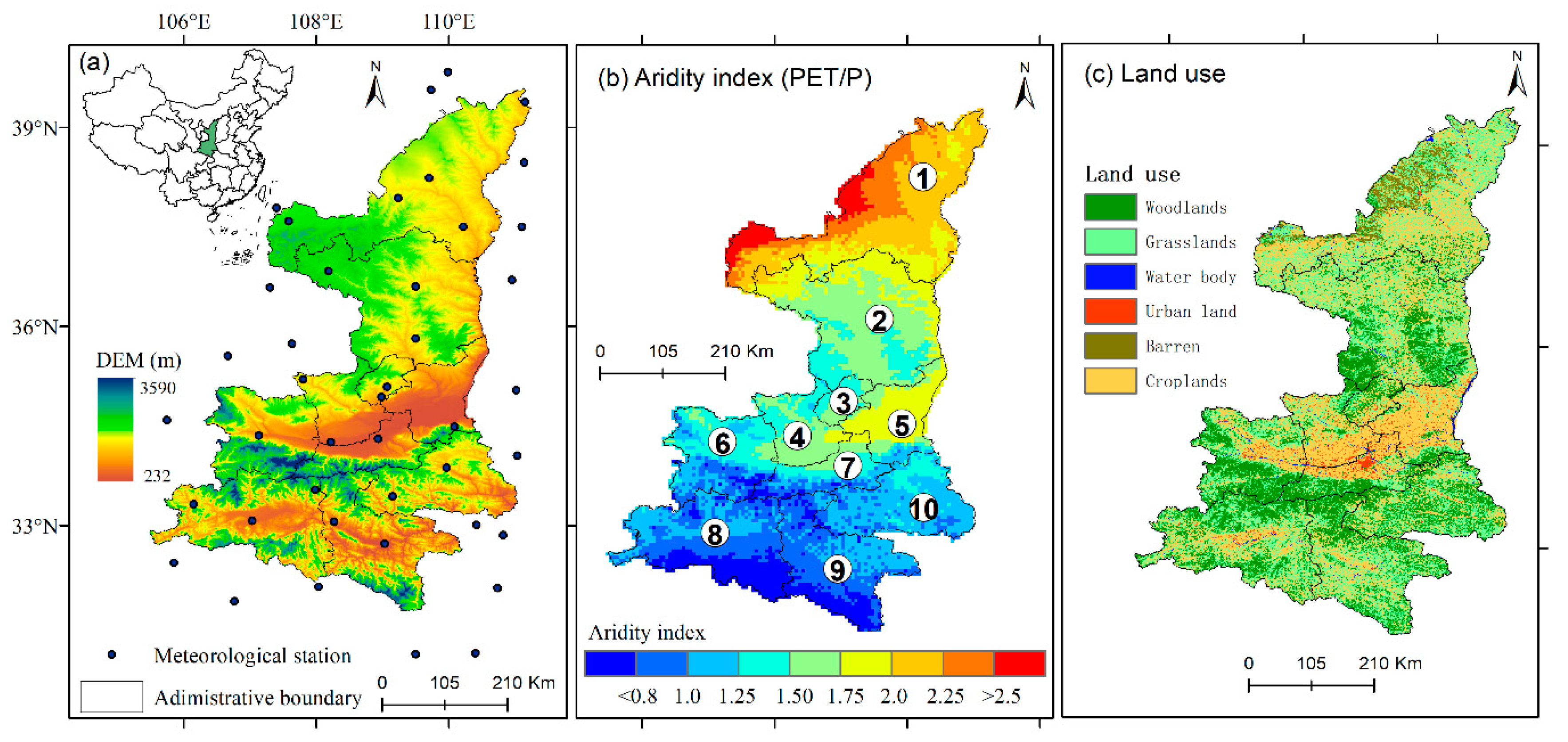
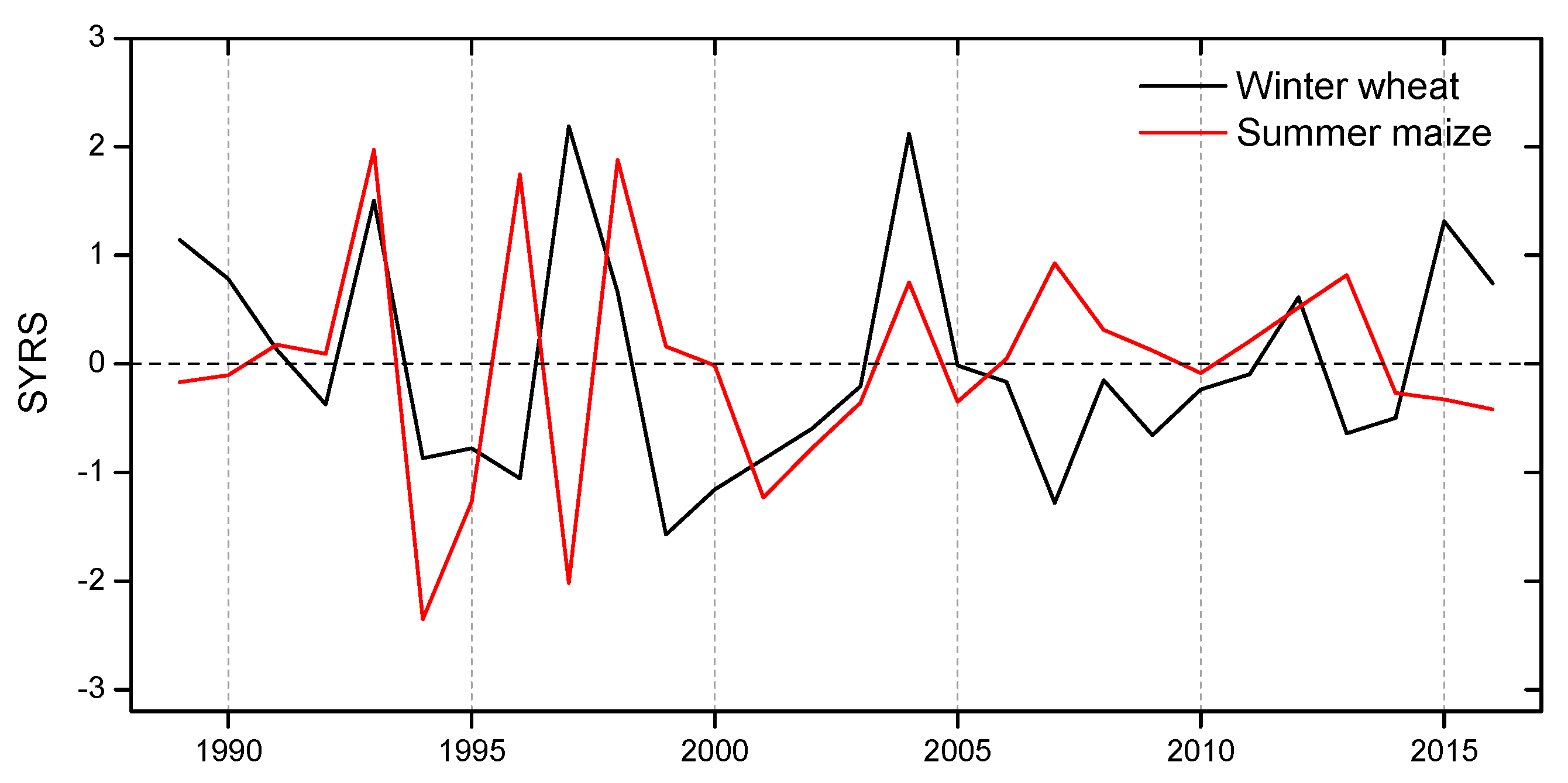
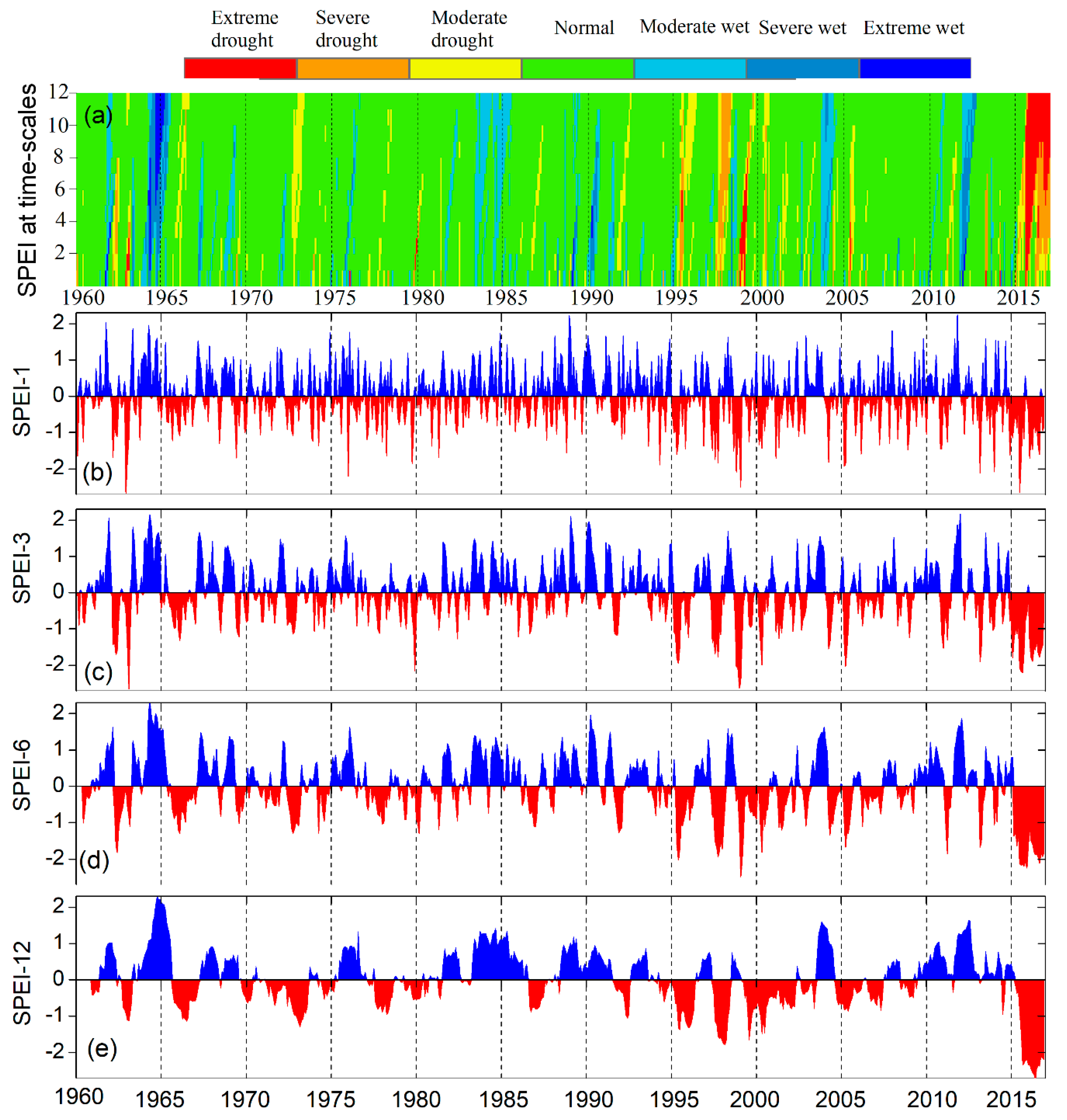

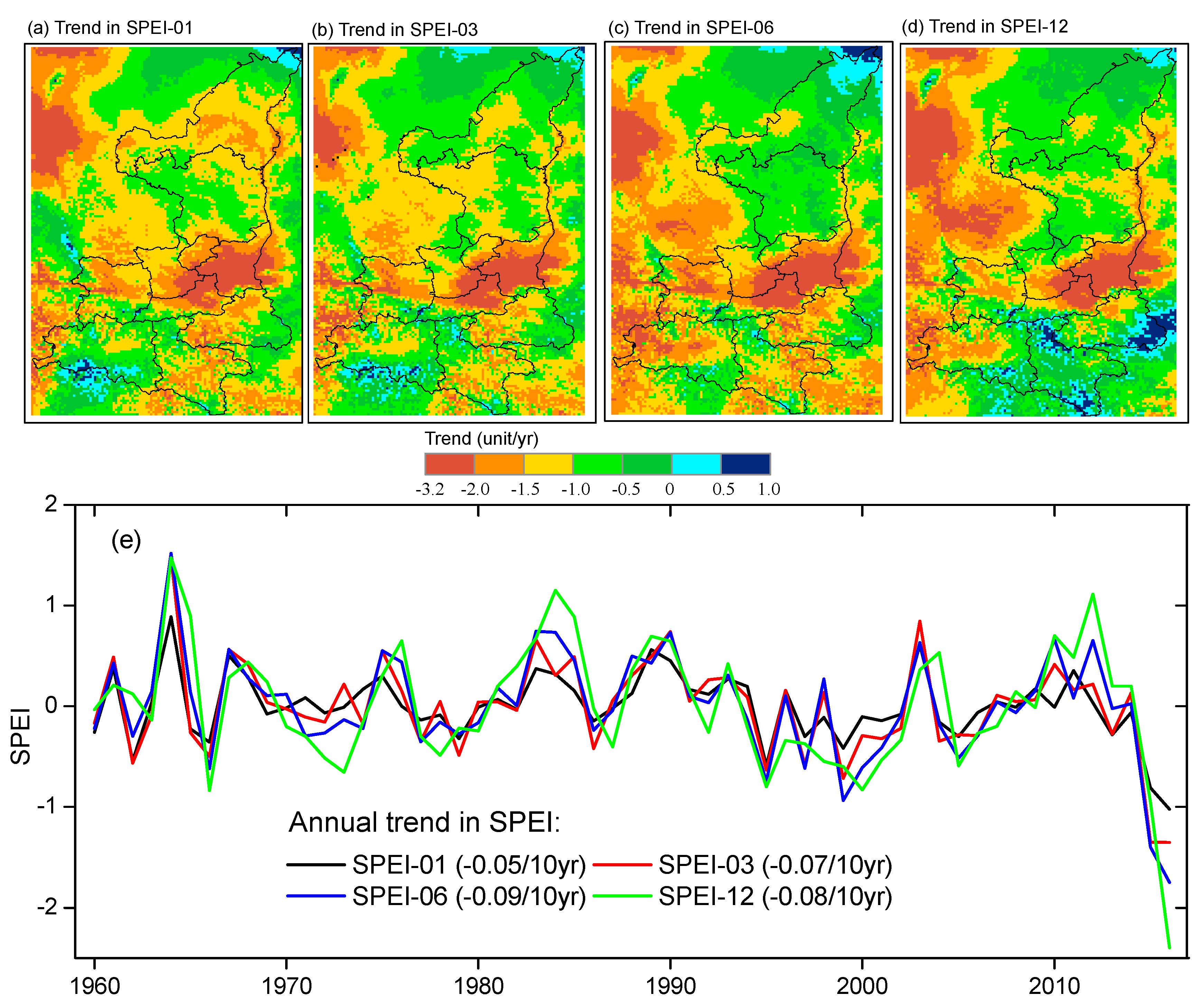
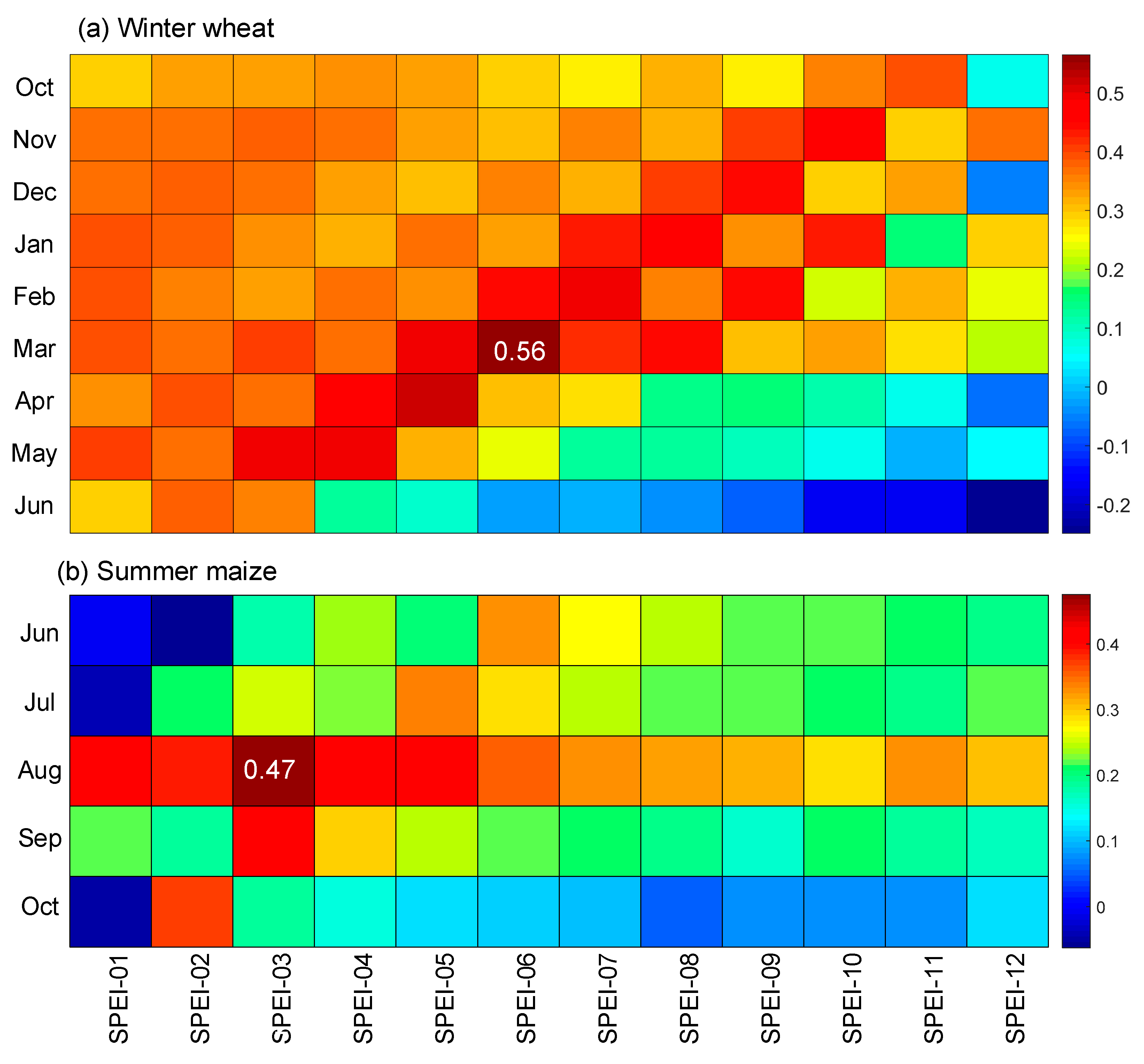
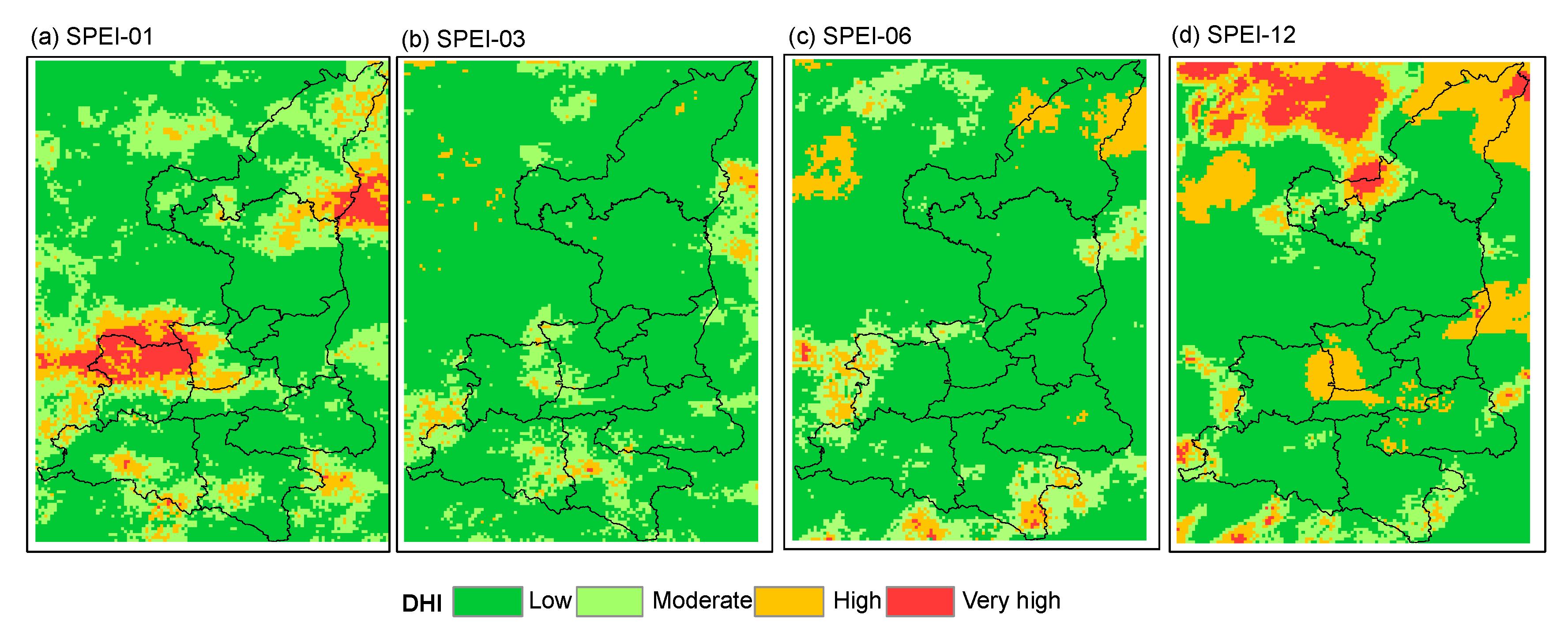
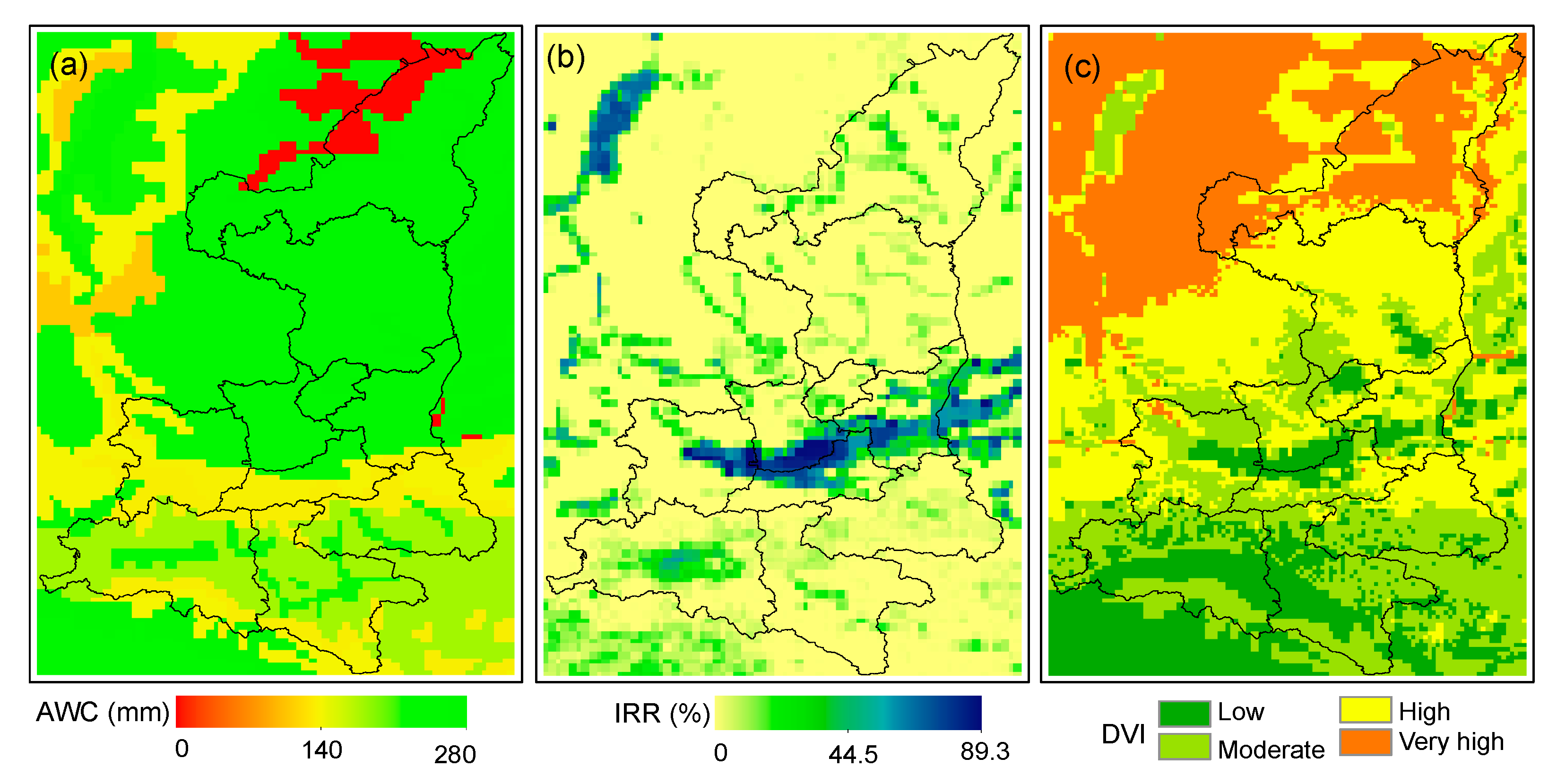

| SPEI | Drought category | SYRS | Category of Yield Losses |
|---|---|---|---|
| –1.0~1.0 | Normal | –0.5~0.5 | Normal |
| –1.5~−1.0 | Moderate drought | –1.0~−0.5 | Low yield losses |
| –2.0~−1.5 | Severe drought | –1.5~−1.0 | Moderate yield losses |
| ≤–2.0 | Extreme drought | ≤–1.5 | High yield losses |
| Drought Intensity | Weight | Frequency (%) | Rating | Vulnerability Factor | Categories | Weight |
|---|---|---|---|---|---|---|
| Moderate | 1 | <9.0 | 1 | Climate (AI) | <1.0 | 1 |
| 9.0–10.0 | 2 | 1.0–1.5 | 2 | |||
| 10.0–11.0 | 3 | 1.5–2.0 | 3 | |||
| >11.0 | 4 | >2.0 | 4 | |||
| Severe | 2 | <3.5 | 1 | Soil (AWC, mm) | >250 | 1 |
| 3.5–4.5 | 2 | 175–250 | 2 | |||
| 4.5–5.5 | 3 | 100–175 | 3 | |||
| >5.5 | 4 | <100 | 4 | |||
| Extreme | 3 | <1.5 | 1 | Irrigation (IRR, %) | >50 | 1 |
| 1.5–2.0 | 2 | 25–50 | 2 | |||
| 2.0–2.5 | 3 | 5–25 | 3 | |||
| >2.5 | 4 | <5 | 4 |
© 2019 by the authors. Licensee MDPI, Basel, Switzerland. This article is an open access article distributed under the terms and conditions of the Creative Commons Attribution (CC BY) license (http://creativecommons.org/licenses/by/4.0/).
Share and Cite
Guo, M.; Li, J.; Wang, Y.; Long, Q.; Bai, P. Spatiotemporal Variations of Meteorological Droughts and the Assessments of Agricultural Drought Risk in a Typical Agricultural Province of China. Atmosphere 2019, 10, 542. https://doi.org/10.3390/atmos10090542
Guo M, Li J, Wang Y, Long Q, Bai P. Spatiotemporal Variations of Meteorological Droughts and the Assessments of Agricultural Drought Risk in a Typical Agricultural Province of China. Atmosphere. 2019; 10(9):542. https://doi.org/10.3390/atmos10090542
Chicago/Turabian StyleGuo, Mengjing, Jing Li, Yongsheng Wang, Qiubo Long, and Peng Bai. 2019. "Spatiotemporal Variations of Meteorological Droughts and the Assessments of Agricultural Drought Risk in a Typical Agricultural Province of China" Atmosphere 10, no. 9: 542. https://doi.org/10.3390/atmos10090542
APA StyleGuo, M., Li, J., Wang, Y., Long, Q., & Bai, P. (2019). Spatiotemporal Variations of Meteorological Droughts and the Assessments of Agricultural Drought Risk in a Typical Agricultural Province of China. Atmosphere, 10(9), 542. https://doi.org/10.3390/atmos10090542





